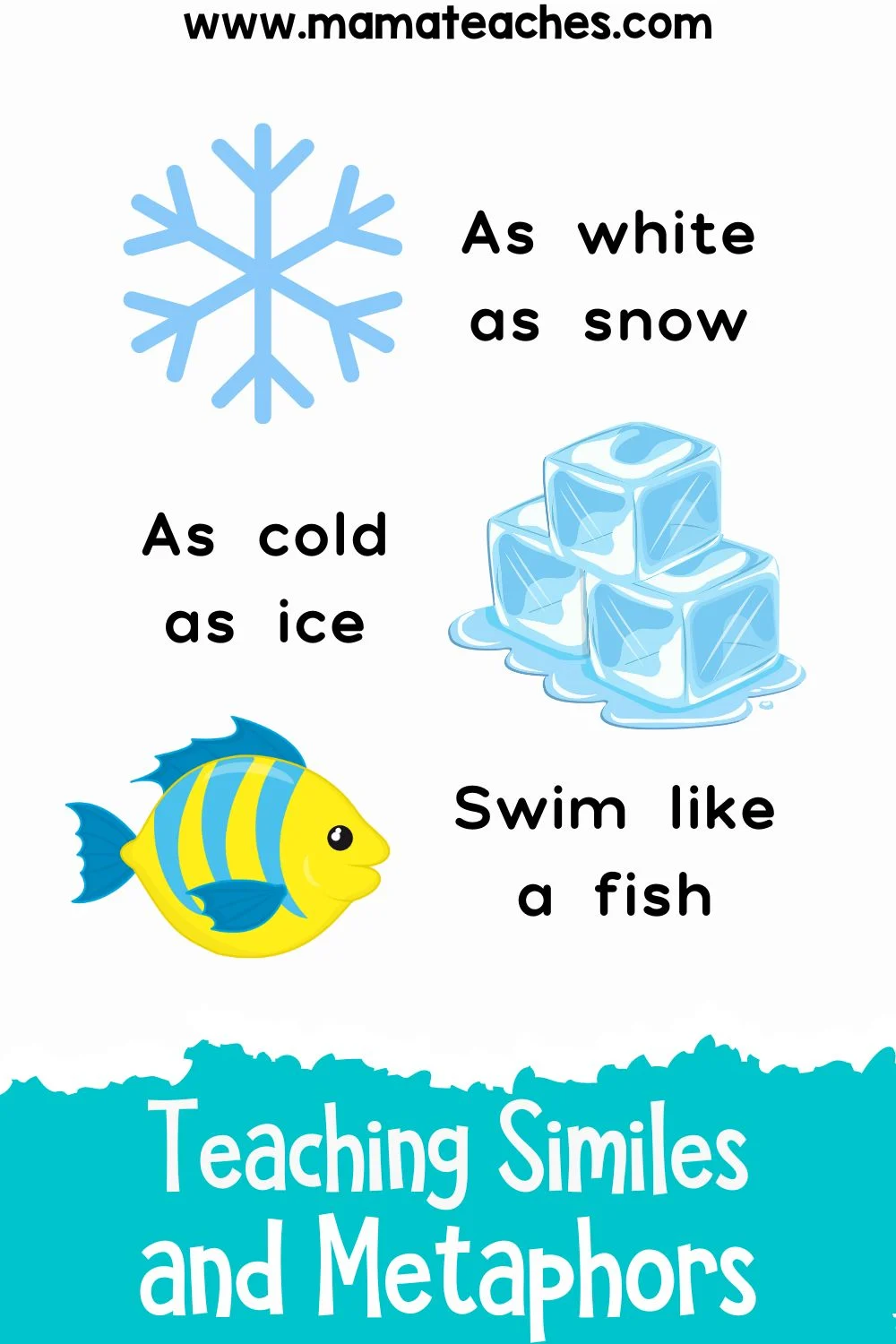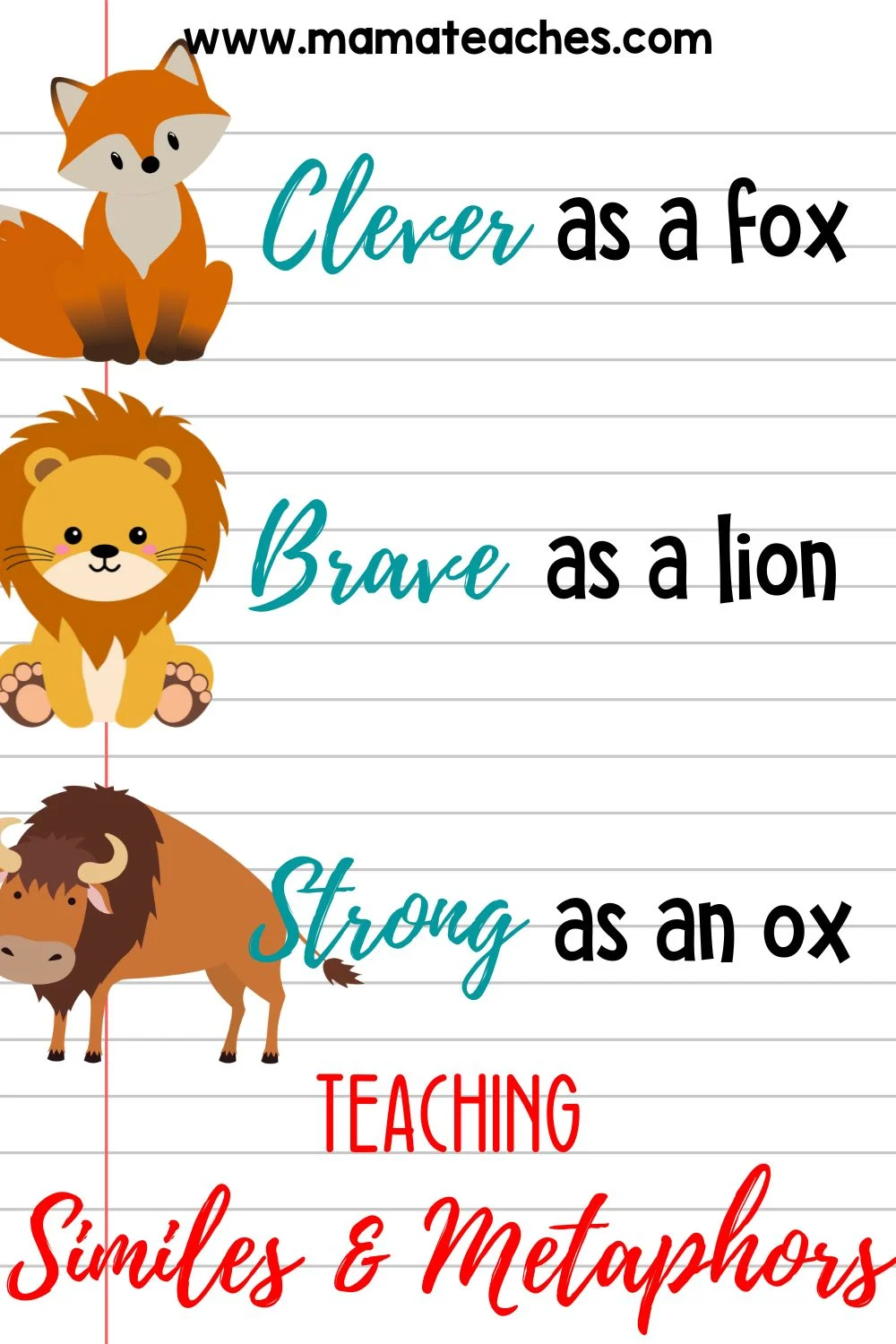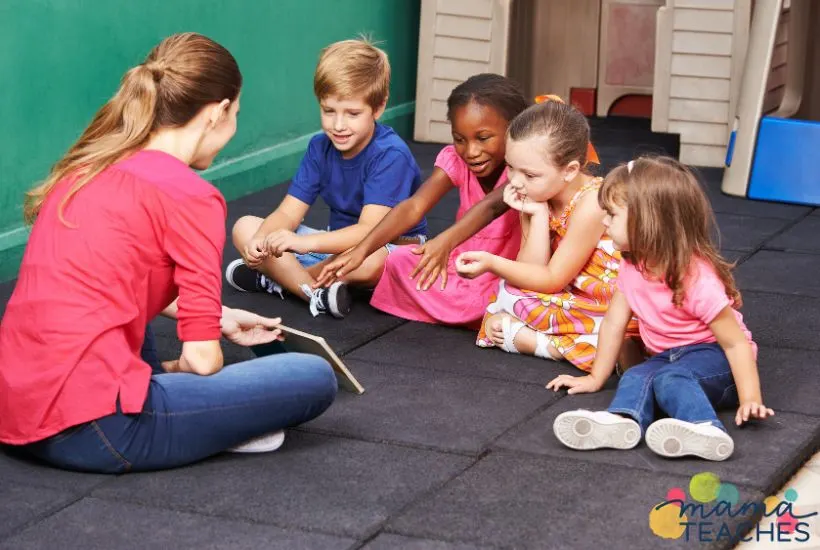How do you teach figurative language like similes and metaphors to students? These activities will work like a magic spell (simile alert!).

What Are Similes and Metaphors?
Similes and metaphors are not literal; they are a form of figurative language.
This means they do not say something directly, but they do convey meaning.
They use descriptive comparisons to do this.

This article contains affiliate links to things that you might like.
Simile and Metaphor Examples
Before you can teach about similes and metaphors, let’s dig into some examples of when and how to use them.
Say you want to express that Lydia is a fast runner.
You can do this literally: “Lydia is a fast runner.”
Or you can compare Lydia to something fast.
A simile uses “like” or “as” to compare two persons or things.
Simile: “Lydia runs like a gazelle.” or “Lydia is as fast as a high-speed train.”
Or you can compare her directly with no “like” or “as.” This is a metaphor.
Metaphor: “Lydia is lightning.” or “Lydia is a cheetah.”
You must compare two things that are dissimilar except for the one thing they have in common.
For instance, “Lydia is as fast as Candace” is not a metaphor. It is not figurative language because it is stating something outright.
Lydia and Candance are already both human runners who are fast. “Lydia is like the jetstream” works much better.

Teaching Similes and Metaphors
How do you teach students about similes and metaphors? Check out these ideas.
Use Lots of Examples
Begin by explaining similes. They are the easier of the two figures of speech to understand.
Then give the students plenty of examples. (You can find examples of similes online or in the recommended book list below.)
Brainstorm with Qualities
Write a quality on the board. This could be anything, such as shy, clever, fast, or heavy.
Under that quality, ask your students to name things that have that quality. Here is an example:
Quality: Large
- tank
- skyscraper
- hot air balloon
- bulldozer
- house
- SUV
- moose
- the Sun

Now you pick something that is also relatively large but dissimilar from the items on the list—for example, a pizza.
Tell your students, “What if you ordered an extra-large pizza and you wanted to exaggerate its size to communicate that it is really, really big?”
Write the phrase on the board: “The pizza was as large as ____.”
Have them take turns filling in the blank with items from your list. Some will sound better than others but affirm each choice.
You can then vote on a class favorite. (Mine is “The pizza was as large as the Sun.”)

Use Cliches
Cliches are overused expressions. They are often similes and metaphors.
Cliches became overused because they were once decent examples of figures of speech. Now they have lost some of their meaning.
People have heard these cliches so much that they no longer think about the comparisons, which means the expressions have lost their punch.
Here are some examples of cliches:
- clever as a fox
- fast as lightning
- sharp as a tack
- brave as a lion
- strong as an ox
You can play a quick matching game to see how many cliches your students know.
Then you can talk about how these cliches came to be.
For example, why would someone say, “So and so was as clever as a fox?” You could mention Aesop’s fables.
Remember, although cliches are interesting to discuss, you must avoid using them in your writing. It’s much better to come up with your own comparison.

Illustrate a Book
A picture of a metaphor is often hilarious. Brainstorm some metaphors as a class. Give each student a unique metaphor.
Write it on a piece of paper, and then attempt to draw it. The results will elicit giggles!
You can do one of these per day and assemble them into a personal book of metaphors for each student.
Here are some ideas of metaphors that would be fun to draw.
- My brother is a mosquito, constantly pestering me. (Draw an actual little brother mosquito buzzing around your head)
- The last sprinkled cookie was my treasure.
- The car is a dinosaur.
- The old computer was a turtle.
- His eyes were shiny quarters.

Picture Match
Give a student a magazine and ask him to cut out appealing pictures (not words). These could be animals, people, plants, foods, or household items.
Can the student find two pictures of completely different items with one thing in common?
For example, the student might pick a flower and a smiling child. Try to make a simile or metaphor.
“The child’s smile bloomed like a rose.”
Write the simile or metaphor on a piece of paper and glue the pictures to it.

Use Sensory Experiences
Bring in items for the students to see, feel, hear, and (perhaps) taste.
Let the students inspect the items, and then have them generate ideas for similes or metaphors.
Here are some items that could work well (and an example of how each could be used).
- marshmallow (“The marshmallow is a spongy pillow.”)
- seashell (“The pink seashell is like a rose petal of the ocean.”)
- slime (“The slime glittered like the night sky.”)
- music box (“The music box twittered like birds.”)
- comb (“The plastic teeth of the comb are a hundred tiny daggers.”)

Books About Similes and Metaphors
Fill your reserve of similes and metaphors with these books.
i never metaphor i didn’t like
This cleverly-titled book has lists of the best similes and metaphors from throughout history.
Similes Dictionary
You look up the topic, and this book will provide you with a simile!
Skin Like Milk, Hair Like Silk
Kids will chuckle over these humorous and rhyming figures of speech and their accompanying illustrations.
Similes and Metaphors Reproducible Activity Book
Are you looking for simple worksheets that introduce and implement the concept of similes and metaphors? Check this out!

How to Teach Similes and Metaphors
Figurative language like similes and metaphors takes time to master. Do not expect students to immediately compose compelling examples.
Teaching similes and metaphors must happen in three steps:
- Fill students with a multitude of examples. Read, read, read!
- Talk through the comparisons.
- Guide students to compose their own examples (you can’t help too much here).
Use the activities in this article to make similes and metaphors understandable and appealing.
